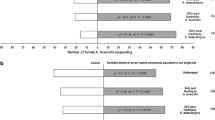Abstract
During a laboratory study evaluatingRhizophagus grandis (a specific native predator of the Eurasian bark beetle,Dendroctonus micans), as a potential biocontrol agent against the North American bark beetle,Dendroctonus valens, it was found that feeding larvae and laboratory-produced frass of the potential prey elicited very high oviposition responses in the predator. Comparative chemical analysis of this laboratory-produced larval frass revealed that one major volatile compound, (-)-fenchone, is associated with the larvae of bothDendroctonus species.D. micans also generated pinocamphone while oxygenated monoterpenes in the frass ofD. valens were camphor,cis-4-thujanol, fenchol, terpinen-4-ol, myrtenal, pinocarvone, borneol, verbenone, piperitone, campholenaldehyde,trans-myrtanol,cis-myrtanol,p-cymen-8-ol and 5-oxo-camphor. This range of prey-produced compounds with a possible biological effect onR. grandis was narrowed down subsequent to comparative analysis of field-collected larval frass. (-)-Fenchone, pinocamphone, camphor, terpinen-4-ol, borneol, fenchol, and verbenone were found to be common to both prey species. A mixture of these seven components was tested in a bioassay, where it elicited as much oviposition as did larval frass ofD. micans. The oviposition stimulants forR. grandis are thus clearly among the mixture's constituents.
Similar content being viewed by others
References
Baisier, ML, andGrégoire, J.-C. 1988. Factors influencing oviposition inRhizophagus grandis (Coleoptera: Rhizophagidae), specific predator of the bark beetleDendroctonus micans (Coleoptera: Scolytidae).Med. Fac. Landbouww. Rijksuniv. Gent 53(3a):1159–1167.
Baisier, M., Grégoire, J.-C, Delinte, K., and`Bonnard, O. 1988. The role of spruce monoterpene derivatives as oviposition stimuli forRhizophagus grandis, a predator of the bark beetle,Dendroctonus micans, pp. 359–368,in W.J. Mattson, J. Lévieux, and C. Bernard-Dagan (eds.). Mechanisms of Woody Plant Defense Against Insects, Springer-Verlag, New York.
Beckmann, S., andMetzger, R. 1956. Über sterisch selektive Reduktion von Ketonen der Campherreihe mit Lithiumaluminiumhydrid.Chem. Ber. 89:2738–2742.
Bergmiller, F. 1903.Dendroctonus micans undRhizophagus grandis.Zentralbl. Ges. Forstw., 29:527–534.
Dagnelie, P. 1970. Théorie et méthodes statistiques, Vol. II. Duculot, Gembloux.
Francke-Grosmann, H. 1954. Population-dynamische Faktoren bei der Massenvermehrung desDendroctonus micans Kug. an der Sitkafichte in Schleswig-Holstein.Verh. Dtsch. Ges. Angew. Entomol. 00:108–117.
Grégoire, J.-C. 1988. The greater European spruce beetle,Dendroctonus micans (Kug.), pp. 455–478,in A.A. Berryman (ed.). Population Dynamics of Forest Insects, Plenum Press, NewYork.
Grégoire, J.-C.,Merlin, J.,Pasteels, J.M.,Jaffuel, R.,Vouland, G., andSchvester, D. 1984. Mass-rearings and releases ofRhizophagus grandis, pp. 122–128,in J.-C. Grégoire and J.M. Pasteels (eds.). Proceedings of the EEC Seminar on the Biological Control of Bark Beetles (Dendroctonus micans), Brussels, October 3–4, 1984.
Heemann, V., andFrancke, W. 1977. Gaschromatographisch-massenspectrometrische Untersuchungen der flüchtigen Rindeninhaltsstoffe vonPicea abies (L.) Karst.Planta Med. 32(4):342–346.
King, C.J., andEvans, H.F. 1984. The rearing ofRhizophagus grandis and its release againstDendroctonus micans in the United Kingdom, pp. 87–97,in J.-C. Grégoire and J.M. Pasteels (eds.). Proceedings of the EEC Seminar on the Biological Control of Bark Beetles (Dendroctonus micans), Brussels, October 3–4, 1984.
Kobakhidze, D.N. 1965. Some results and prospects of the utilization of beneficial entomophagous insects in the control of insect pests in Georgian SSR (USSR).Entomophaga 10(4):323–330.
König, W.A., Krebber, R., andMischnick, P. 1989. Cyclodextrines as chiral stationary phases in capillary gas chromatography.J. HRC 12:732–738.
Miller, M.C., Moser, J.C., McGregor, M., Grégoire, J.-C, Baisier, M., Dahlsten, D.L., andWerner, R.A. 1987. The potential for biological control of native North American bark beetles (Coleoptera: Scolytidae).Ann. Entomol. Soc. Am. 80(3):417–428.
Moser, J.C. 1989. Inoculative release of an exotic predator for the biological control of the black turpentine beetle, pp. 189–200,in D.L. Kulhavy and M.C. Miller (eds.). Potential for Biological Control of Dendroctonus and Ips Bark Beetles. Stephen F. Austin State University, Nacogdoches, Texas, 255 pp.
Smith, R.H. 1971. Red turpentine Beetle. USDA Forest Service Forest Pest Leaflet.
Stock, M.W., Grégoire, J.-C., andFurniss, M.M. 1987. Electrophoretic comparison of EuropeanDendroctonus micans and ten North AmericanDendroctonus species (Coleoptera: Scolytidae).Pan-Pac. Entomol. 63(4):353–357.
Zweifel, G., andBrown, H.C. 1964. Hydroboration of terpenes. II. The hydroboration of α- and β-pinene. The absolute configuration of the dialkylborane from the hydroboration of α-pinene.J. Am. Chem. Soc. 86:393–397.
Author information
Authors and Affiliations
Rights and permissions
About this article
Cite this article
Grégoire, J.C., Baisier, M., Drumont, A. et al. Volatile compounds in the larval frass ofDendroctonus valens andDendroctonus micans (Coleoptera: Scolytidae) in relation to oviposition by the predator,Rhizophagus grandis (Coleoptera: Rhizophagidae). J Chem Ecol 17, 2003–2019 (1991). https://doi.org/10.1007/BF00992584
Received:
Accepted:
Issue Date:
DOI: https://doi.org/10.1007/BF00992584




